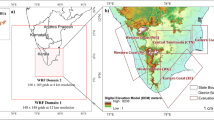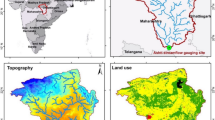Abstract
Despite the enormous damage caused by record heavy rainfall, the amount of precipitation in areas without observation points cannot be known precisely. One way to overcome these difficulties is to estimate meteorological data at ungauged sites. In this study, we have used observation data over Seoul city to calculate high-resolution (250-meter resolution) synthetic precipitation over a 10-year (2005-2014) period. Furthermore, three cases are analyzed by evaluating the rainfall intensity and performing statistical analysis over the 10-year period. In the case where the typhoon “Meari” passed to the west coast during 28-30 June 2011, the Pearson correlation coefficient was 0.93 for seven validation points, which implies that the temporal correlation between the observed precipitation and synthetic precipitation was very good. It can be confirmed that the time series of observation and synthetic precipitation in the period almost completely matches the observed rainfall. On June 28-29, 2011, the estimation of 10 to 30 mm h−1 of continuous strong precipitation was correct. In addition, it is shown that the synthetic precipitation closely follows the observed precipitation for all three cases. Statistical analysis of 10 years of data reveals a very high correlation coefficient between synthetic precipitation and observed rainfall (0.86). Thus, synthetic precipitation data show good agreement with the observations. Therefore, the 250-m resolution synthetic precipitation amount calculated in this study is useful as basic data in weather applications, such as urban flood detection.
Similar content being viewed by others
References
Bae, H. J., 2015: Study on a Method for Synthetic Precipitation Data for Ungauged Sites Using Quantitative Precipitation Model. M.S. thesis, Dpartment of Environmental Atmospheric Sciences, Pukyong National University, 8 pp.
Beck, A., B. Ahrens, and K. Stadlbacher, 2004: Impact of nesting strategies in dynamical downscaling of reanalysis data, Geophys. Res. Lett., 31, L19101, doi:10.1029/2004GL020115.
Environmental Modeling Center, 2003: The GFS Atmospheric Model. NCEP Office Note 442, 14 pp.
Hirt, C., M. S. Filmer, and W. E. Featherstone, 2010: Comparison and validation of the recent freely available ASTER-GDEM ver1, SRTM ver4.1 and GEODATA DEM-9S ver3 digital elevation models over Australia. Aust. J. Earth Sci., 57, 337–347, doi:10.1080/0812009100-3677553.
Hong, W.-H., H.-S. Oh, and G.-K. Yi, 2005: A study on flood control measures and the damage of an urban area by the severe rain storm in Daegu City. J. Archit. Inst. Korea Plann. and Design, 21, 183–190 (in Korean with English abstract).
Kim, J.-Y., J.-H. Oh, D.-Y. Kim, and P. Sen, 2008: Prediction of rainfall with high-resolution QPF model using public-resource distributed computing. Asia-Pac. Atmos. Sci., 44, 287–296.
Kim, O.-Y., and J.-H. Oh, 2010: Verification of the performance of the high-resolution QPF model for heavy rainfall event over the Korean peninsula. Asia-Pac. Atmos. Sci., 46, 119–133, doi:10.1007/s13143-010-0012-5.
Kim, M.-K., D.-H. Lee, and J. Kim, 2013: Production and validation of daily grid data with 1 km resolution in South Korea. J. Climate Res., 8, 13–25.
Palecki, M. A., J. R. Angel, and S. E. Hollinger, 2005: Storm precipitation in the United States. Part I: Meteorological characteristics. J. Appl. Meteorol., 44, 933–946, doi:10.1175/JAM2243.1.
Shin, S.-C., M.-K. Kim, M.-S. Suh, D.-K. Rha, D.-H. Jang, C.-S. Kim, W.-S. Lee, and Y.-H. Kim, 2008: Estimation of high resolution gridded precipitation using GIS and PRISM. Atmosphere, 18, 71–81 (in Korean with English abstract).
Shin, S.-Y., and C.-Y. Park, 2014: Analyzing relationships between land use characteristics and flood damage areas: The Case of Seoul. The Korea Spatial Planning Review, 81, 3–20 (in Korean).
Singh, V. P., and D. K. Frevert, 2002a: Mathematical Models of Large-Watershed Hydrology. Water resources Publications, LLC, 891 pp.
Singh, V. P., and D. K. Frevert, 2002b: Mathematical Models of Small Watershed Hydrology and Applications. Water resources Publications, LLC, 950 pp.
Skoda, G., V. Weilguni, and T. Haiden, 2003: Heavy convective storms -precipitation during 15, 60, and 180 minutes. Hydrological Atlas of Austria, 2, 5–7.
Author information
Authors and Affiliations
Corresponding author
Rights and permissions
About this article
Cite this article
Kim, HJ., Choi, KM. & Oh, JH. An Ultra-high Resolution Synthetic Precipitation Data for Ungauged Sites. Asia-Pacific J Atmos Sci 54, 215–223 (2018). https://doi.org/10.1007/s13143-018-0005-3
Received:
Accepted:
Published:
Issue Date:
DOI: https://doi.org/10.1007/s13143-018-0005-3




